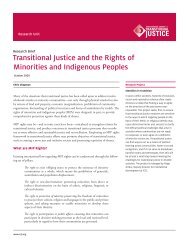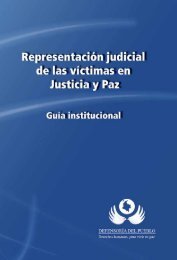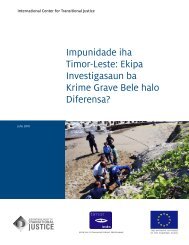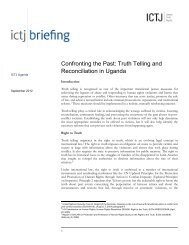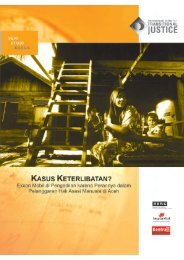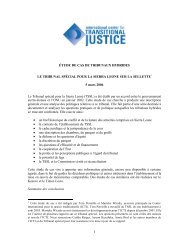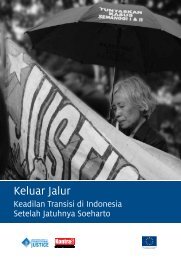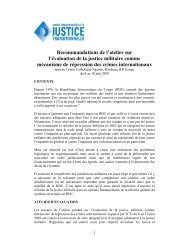That Someone Guilty Be Punished - International Center for ...
That Someone Guilty Be Punished - International Center for ...
That Someone Guilty Be Punished - International Center for ...
You also want an ePaper? Increase the reach of your titles
YUMPU automatically turns print PDFs into web optimized ePapers that Google loves.
C. Peace and Justice<br />
If the ICTY faced daunting practical challenges in its early years, political challenges were<br />
just as <strong>for</strong>midable. From the outset of the Tribunal’s work, diplomats working to bring the<br />
conflict in Bosnia to a negotiated end feared that the ICTY might impede their ef<strong>for</strong>ts. 64 As we<br />
explain in Chapter III, one of the principal justifications the Security Council cited in establishing<br />
the ICTY was its conviction that the Tribunal would help restore and maintain peace<br />
in a region still at war. But from the outset of his work, Chief Prosecutor Richard Goldstone<br />
had to address diplomats’ attraction to the idea of offering deals that might include promises<br />
of immunity to suspected war criminals in exchange <strong>for</strong> a peace agreement. 65 After all, <strong>for</strong> a<br />
time the chief negotiator on behalf of Bosnian Serbs was Radovan Karadžić, a man who risked<br />
indictment someday—and indeed is now on trial in The Hague—<strong>for</strong> his leadership role in<br />
“ethnic cleansing.” 66<br />
A massacre that would surpass all others in the war brought this issue to a head. For<br />
several days in July 1995, Bosnian Serb <strong>for</strong>ces systematically executed more than 7,000 Muslim<br />
males who, with their families, had been living in the eastern Bosnian town of Srebrenica.<br />
The final operation, 67 which would later be judged a genocide by both the ICTY and the<br />
<strong>International</strong> Court of Justice, began on July 11, 1995. By July 25, 1995, the ICTY had issued<br />
an indictment charging wartime Bosnian Serb leaders Radovan Karadžić and Ratko Mladić<br />
with genocide and other crimes. This indictment did not include the July 1995 massacre in<br />
Srebrenica—the prosecutor had not yet had time to prepare an indictment <strong>for</strong> this—but it is<br />
widely thought that Goldstone rushed out an indictment already in the works to ensure a swift<br />
response to Srebrenica. 68 While much of the world welcomed the long-awaited indictment,<br />
then UN Secretary-General Boutros Boutros-Ghali later told Goldstone that, had the prosecutor<br />
consulted him first, he would have advised against indicting Karadžić “be<strong>for</strong>e peace had<br />
been brokered in Bosnia.” 69<br />
Although long authorized to use military <strong>for</strong>ce to protect Srebrenica and other so-called<br />
“safe areas” in Bosnia, NATO had been reluctant to do so. 70 But the Srebrenica massacre,<br />
soon followed by another in downtown Sarajevo, finally led NATO to use unprecedented firepower<br />
against Bosnian Serb <strong>for</strong>ces in late August 1995. 71 NATO’s intervention, along with the<br />
crippling effects of international sanctions against Serbia and a decisive Croatian offensive<br />
against Serb <strong>for</strong>ces in the Croatian-Serb war, brought Serb leaders to the negotiating table,<br />
now under U.S. mediation. After years of inconclusive negotiations under European and then<br />
joint European-United Nations auspices, this time the Serbs were ready to reach an agreement<br />
to end the war.<br />
Less than four months after the Srebrenica massacres, peace talks led by U.S. negotiator<br />
Richard Holbrooke got underway at the Wright Patterson Air Force Base outside Dayton, Ohio.<br />
In the lead-up to Dayton, U.S. officials were divided about whether Karadžić and Mladić—now<br />
26 BACKGROUND




